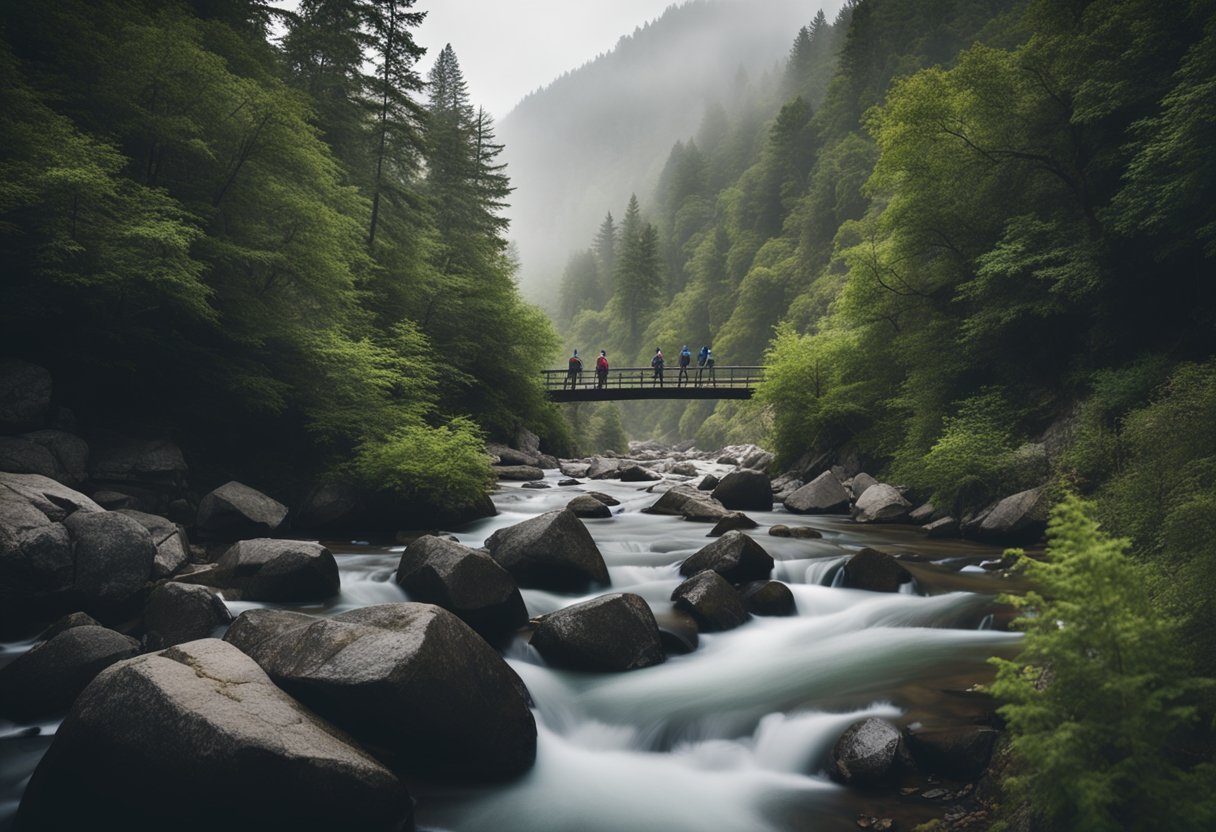The Appalachian Trail: Epic Tales from America’s Premier Footpath

Updated On: March 18, 2024 by Eman Sameh
Spanning approximately 3,500 kilometres along the eastern United States, the Appalachian Trail beckons as a siren call to adventurers and nature enthusiasts alike. As America’s longest hiking path, this storied trail offers a unique blend of natural beauty, challenging terrain, and a rich tapestry of American history. From the humble peaks of Springer Mountain in Georgia to the formidable heights of Mount Katahdin in Maine, the trail weaves through diverse landscapes and ecosystems, hosting a myriad of wildlife and flora.

The Appalachian Trail is not just a path through the woods—it is a journey through time, a conduit for stories, and a platform for personal transformation. Embarking on this trail, whether for a short hike or a complete thru-hike, is participating in a tradition that dates back to the trail’s inception in the 1920s. The experiences garnered along the way are as varied as the hikers who tread its path, encompassing moments of solitude, camaraderie, triumph, and introspection. The trail’s allure lies not just in its scale but in the myriad of experiences it offers, shaped by changing seasons, varying terrains, and the character of each state it passes through.
Our preparations for a hike on the Appalachian Trail are as essential as the journey itself. Proper planning ensures a rewarding experience while preserving the trail for future generations. From understanding leave-no-trace ethics to choosing the right gear, every step taken in preparation is a step towards a successful and responsible hike. As we traverse the trail’s iconic landmarks and confront its challenges, we become part of its ongoing narrative—a narrative that every hiker helps to shape.
History and Founding

As we delve into the Appalachian Trail’s stories, understanding its origins is crucial. The path we now traverse has a history that intertwines vision with preservation and community efforts.
Early Beginnings: 1921 and 1937
The Appalachian Trail was first conceptualised in 1921. This year, Benton MacKaye, a land-use planner, introduced his idea of a continuous trail stretching along the Appalachian Mountains. MacKaye’s vision was not just for a hiking path but for a project that would encompass environmental preservation and social good. This vision took its first step towards reality in 1937, when, after years of volunteer effort and coordination, the trail was officially completed, running from Georgia to Maine.
Benton MacKaye and the Appalachian Trail Conservancy
Benton MacKaye is considered the founding father of the Appalachian Trail. His commitment to the outdoors and sustainable development laid the groundwork for what would become a national treasure. MacKaye’s dream was sustained and flourished through the efforts of the Appalachian Trail Conservancy (ATC), an organization established to preserve and manage the trail. The ATC, founded in 1925, has been instrumental in protecting the trail and ensuring that it remains an escape into nature for millions to enjoy.
Geography and Landscape

As we explore America’s longest hiking path, the Appalachian Trail, we uncover a stretch of diverse terrain that spans over 3,500 kilometres. This journey not only connects us from Georgia to Maine but also to a variety of ecosystems, including majestic peaks and the tranquillity of extensive forests and parks.
From Georgia to Maine
The Appalachian Trail begins its epic journey in the southern charm of Georgia’s Springer Mountain, winding its way northward to the rugged grandeur of Mount Katahdin in Maine. Traversing 14 states, the path carries us through a rich tapestry of American geography, inviting us to witness the shifting landscapes from south to north.
Key Peaks and Vista Points
As we progress, the trail offers the opportunity to encounter some of the most spectacular peaks and vista points in the Appalachian Mountains. Notable summits such as Clingmans Dome present breathtaking panoramas, while the lofty elevations of the White Mountains in New Hampshire provide an entirely different perspective of the trail’s splendour.
Major Forests and National Parks
Meandering through significant swathes of forestland, the trail offers an immersion into the serene beauty of environments like the Great Smoky Mountains. Nature’s resilience is on full display in the protected expanses of these forests and national parks, which serve as sanctuaries for countless native flora and fauna, echoing the importance of conservation and our connection to these landscapes.
The Hiking Experience

Embarking on the Appalachian Trail presents a tapestry of terrains and natural spectacles. We’ll explore the trail conditions one will face, the variable weather and climate, and the abundant wildlife and flora to be encountered along this storied path.
Terrain and Trail Conditions
The Appalachian Trail offers a wild diversity of terrain, from rugged mountain ridges to dense forests and serene valleys. Hikers will navigate rocky inclines, meandering streams, and occasionally, well-maintained paths. The challenge lies in the trail’s ever-changing nature, which can turn from a gentle walk to a gruelling climb within a matter of miles.
Weather and Climate Factors
Weather along the trail can be as unpredictable as the terrain itself. Climates range from humid summers in the southern states, where afternoon storms are common, to the harsh, cold conditions of the New England mountains. Hikers should prepare for all extremes and remain flexible with their planning to account for weather variations.
Wildlife and Flora
The Appalachian Trail is a haven for wildlife enthusiasts, with opportunities to spot deer, black bears, and a wide range of bird species. The path is also lined with an array of wildflowers and plants, adding pops of colour and interest to the journey. The trail is not only a challenge; it immerses us in a vibrant nature experience that epitomises true Wilderness.
Planning Your Hike

Before we embark on this adventure along the Appalachian Trail, it’s essential to focus on preparing meticulously. Our journey’s success hinges upon careful planning, selecting the right gear, strategic resupplying, and prioritising our safety and health.
Choosing Your Gear
Our backpack is the cornerstone of our gear, pivotal for balancing weight and comfort. For footwear, hiking boots are a must, offering ankle support and traction. Let’s opt for lightweight, moisture-wicking clothing to adapt to varying temperatures and a compact yet effective sleep system for resting in diverse conditions.
Resupply and Logistics
We’ll meticulously map out resupply points to replenish our resources. Lightweight, energy-dense foods that require minimal cooking are ideal for sustenance while on the trail. It’s important to strategise our resupply points considering the distances and our capacity to carry supplies without overburdening ourselves.
Safety and Health Considerations
Our health and safety are paramount on the Appalachian Trail. We must plan for hydration by knowing our water sources and using a reliable water treatment method. Additionally, we’ll carry a first-aid kit tailored to our group’s specific needs and have contingency plans for any emergencies that might arise. It’s crucial to educate ourselves on the symptoms of common trail ailments and how to prevent them.
By focusing on these planning essentials, let’s ensure our hike is memorable for all the right reasons.
Hiking Etiquette and Conservation

When we explore the Appalachian Trail, our conduct and dedication to conservation are vital to preserving both the natural environment and the hiking community’s integrity. With every step, we shoulder the responsibility to hike respectfully and participate actively in the trail’s upkeep.
Leave No Trace Principles
Leave No Trace is more than a set of rules; it’s a philosophy ensuring that our outdoor activities have minimal impact on the environment. These principles are the core of our ethic as hikers on the Appalachian Trail:
- Plan Ahead and Prepare: Adequate planning prevents us from creating unnecessary harm to the trail by reducing the likelihood of having to rely on trail resources or emergency services.
- Travel and Camp on Durable Surfaces: To prevent soil erosion, we stick to established trails and camp at designated sites.
- Dispose of Waste Properly: All litter, be it natural or man-made, must be packed out. We also strive to dispose of human waste appropriately and maintain the trail’s cleanliness.
- Leave What You Find: We do not disturb historical or natural artefacts, allowing others to experience the trail as we found it.
- Minimise Campfire Impacts: We reduce campfire impacts by using stoves instead and avoiding fires unless in a dire emergency.
- Respect Wildlife: We observe wildlife from a distance, refraining from feeding or disturbing their natural behaviours.
- Be Considerate of Other Visitors: By yielding to others on the trail and being discreet in our use of shelters and campsites, we contribute to everyone’s enjoyment.
Trail Angels and Community Support
“Trail Angels” embodies the spirit of the Appalachian Trail community. These selfless volunteers provide assistance to hikers in a variety of forms, ranging from offering lifts to trailheads or supplying food and water caches. This support is essential:
- Water Stations: Trail Angels often leave water supplies at critical points along the trail, especially in areas where natural water sources are scarce.
- Shuttles: They also frequently volunteer to shuttle hikers to nearby towns for supplies or to help bypass hazardous sections.
By adhering to the Leave No Trace Principles and appreciating the contributions of Trail Angels, we take on the responsibility to conserve the trail for future generations. This active participation in conservation efforts and community support ensures the longevity and beauty of the Appalachian Trail.
Accommodations and Amenities

As hikers traverse the Appalachian Trail, they can access various accommodation options and amenities that cater to their needs.
Shelters and Camps
Along the Appalachian Trail, we find over 250 shelters meant for short overnight stays. Shelters, also known as lean-tos, are spaced roughly a day’s hike apart from each other and are available on a first-come, first-served basis. Most have a wooden floor and a roof, offering protection against the elements. Additionally, camps provide a place for tents, with many located near water sources and privies.
- Shelters: First-come, first-served; usually includes a roof and basic sleeping platform.
- Camps: Designated areas that may include pit toilets and water sources.
Trail Towns and Services
Trail towns appear periodically along the Appalachian Trail and are a vital part of the hiking experience. In these towns, hikers can resupply, find lodging, and perhaps enjoy a well-deserved hot meal. Essential amenities such as grocery stores, outdoor retailers, laundromats, and post offices can be found here. An example to highlight is the inn-to-inn hiking experience available in some regions, such as Shenandoah National Park, offering a comfortable bed and warm meals during a multi-day adventure.
- Trail towns: Provide food, lodging, gear supplies, and medical services.
- Services: Including opportunities for laundry, showers, and resupplying essentials.
These fundamental accommodations and services support the journey along the Appalachian Trail, ensuring that hikers can focus on the experience while remaining comfortable and practical.
Thru-Hiking vs Section Hiking

When we embark on the Appalachian Trail, we face a choice: commit to the entire trail for a transformative journey or tackle it in segments as time allows.
Full Trail Experience: Thru-Hiking
Thru-hiking the Appalachian Trail is the ultimate challenge that calls for a full commitment to hiking the entire 3,500 kilometres from Georgia to Maine. It’s a test of endurance and adventure that can take 5 to 7 months to complete. Thru-hikers experience various emotions, from the thrill of success to the trial of physical and mental challenges. This continuous journey creates a comprehensive narrative of the trail’s changing landscapes and an intimate connection with nature that section hiking doesn’t quite capture.
- Benefits: Complete trial experience, deep immersion, and an intense sense of accomplishment.
- Challenges: Requires significant time commitment, physical and mental demands, and logistical planning.
- Success: Achieved through preparation and resilience, support from the hiking community, and strategic resupplying.
Bite-Sized Adventures: Section Hiking
Alternatively, section hiking allows us to experience the Appalachian Trail in smaller, more manageable parts. This approach gives flexibility, making the trail accessible to those of us with constraints on our time. Despite the division into sections, the cumulative accomplishment over time can still be substantial. Each section hike can act as a self-contained adventure, presenting its own unique challenges and rewards. It also allows the opportunity to experience the trail in different seasons.
- Benefits: Flexible scheduling tailored to our individual endurance levels; variety of experiences.
- Challenges: Maintaining continuity and momentum over time; varying conditions.
- Success: Measured in incremental achievements; allows for a balance with other life commitments; can often be combined with local events.
By understanding the differences between thru-hiking and section hiking, we can make informed decisions about how to approach this iconic adventure in a manner that suits our personal goals and circumstances.
Notable Sections and Landmarks

The Appalachian Trail captivates with its array of famous stretches and historical landmarks. From the breathtaking views of McAfee Knob to the rugged terrains of the White Mountains, each segment presents an opportunity to witness the beauty and history of this iconic path.
Iconic Points: McAfee Knob and More
McAfee Knob is renowned as the most photographed location on the Appalachian Trail. Its panoramic views offer a memorable reward for those who make the ascent. Not far from this landmark, the trail town of Damascus is fondly known as the “Friendliest Town on the Trail,” and for good reason – its annual Trail Days festival celebrates the unique culture of the hiking community.
Great Smoky Mountains National Park
As we explore further, Great Smoky Mountains National Park stands out as a major highlight. This UNESCO World Heritage Site is not only a haven for diverse flora and fauna but also a challenging stretch with Clingmans Dome, the trail’s highest point. Hikers find themselves enveloped in mist-covered mountains, creating a mystical experience hard to replicate elsewhere.
The White Mountains of New Hampshire
Further north, the White Mountains of New Hampshire offer some of the trail’s most awe-inspiring landscapes. The perilous yet stunning peaks of the Presidential Range, including Mount Washington, test the mettle of trekkers. Their efforts are rewarded with some of the most striking vistas the trail has to offer, where human perseverance meets the untamed spirit of nature.
Challenges and Obstacles

Embarking on a journey along the Appalachian Trail, hikers face a myriad of challenges and obstacles. From the treacherous terrain to unpredictable weather, each step can test the limits of one’s endurance and preparation.
Navigating Difficult Terrain
The rugged landscape of the Appalachian Trail presents a variety of difficult terrain. Hikers must traverse steep peaks, navigate through dense rocky paths, and sometimes contend with muddy sections that can impede progress. Suitable footwear is essential for stability and to protect against the uneven ground. The challenge of climbing in certain areas cannot be underestimated, requiring both physical and mental fortitude.
Weather-Related Challenges
The weather poses another significant challenge. Hikers can face intense heat, heavy rain, or even a sudden hurricane. These conditions not only affect visibility and stability but also present hazards such as falling limbs or slippery surfaces. Preparing for weather-related challenges involves careful planning, with an understanding that conditions can change rapidly and without warning on the trail.
Frequently Asked Questions

Navigating the Appalachian Trail sparks many questions. Here, we address some of the key inquiries hikers and enthusiasts often have.
What are the most remarkable tales of the Appalachian Trail?
The trail has seen incredible journeys, including stories of resilience and camaraderie. One can uncover these tales from the Appalachian Trail that include historical backgrounds and personal triumphs.
Can one access the Appalachian Trail map for hiking purposes?
Yes, detailed maps are available, ensuring hikers can plan and track their route confidently. The Appalachian Trail Conservancy provides these essential resources.
Which documentaries about the Appalachian Trail come highly recommended?
Several documentaries offer inspiring insights into the trail. They showcase both the majestic natural beauty and the human stories that intertwine with this remarkable path.
How much time is typically required to complete the Appalachian Trail?
Completing the entire trail is a substantial commitment, often taking 5 to 7 months. Factors such as weather, fitness, and hiking pace influence the duration.
Have there been any significant incidents on the Appalachian Trail?
While the trail is generally safe, there have been occasional reports of wildlife encounters and weather-related incidents. Hikers are advised to prepare well and stay informed.
Which books detail women’s experiences hiking the Appalachian Trail?
There are several compelling books authored by women who’ve taken on the trail, offering unique perspectives and valuable insights into the solo female hiking experience.






